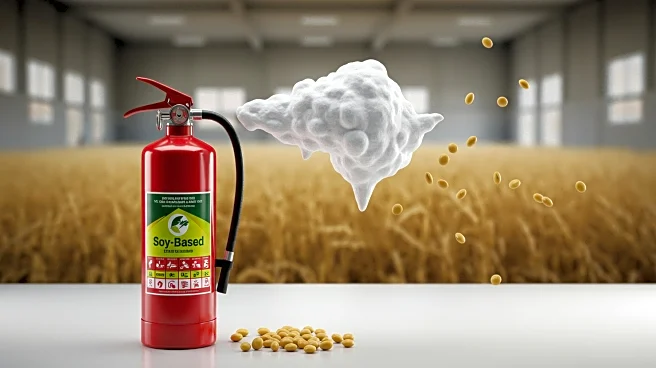What's Happening?
The United Soybean Board has introduced a new firefighting foam called SoyFoam, which utilizes soy flour as a base. This innovative product is biodegradable and environmentally friendly, offering a safer alternative to traditional firefighting foams that contain 'forever chemicals.' SoyFoam combines the properties of Class A and Class B foams, making it effective for both natural and combustible fires. The foam has been adopted by fire departments across the United States, with Kentucky serving as a proving ground due to the efforts of local farmer Jeff King. King, who is also an assistant chief at a rural volunteer fire department, has been instrumental in promoting SoyFoam's benefits, leading to its adoption by other departments.
Why It's Important?
The introduction of SoyFoam represents a significant advancement in sustainable firefighting technology, providing a new market for soy farmers. By utilizing leftover soy flour, the product not only helps reduce waste but also expands the soybean market. This development aligns with broader environmental goals, such as reducing land use and carbon footprint, and minimizing soil erosion. The adoption of SoyFoam by fire departments highlights the growing demand for eco-friendly solutions in emergency services, potentially leading to increased soybean production and economic benefits for farmers.
What's Next?
As more fire departments across the U.S. adopt SoyFoam, the demand for soy flour is expected to rise, potentially leading to increased soybean cultivation. The United Soybean Board may continue to explore other innovative uses for soy products, further expanding the market for farmers. Additionally, the success of SoyFoam could encourage other industries to seek sustainable alternatives, driving further research and development in eco-friendly technologies.
Beyond the Headlines
The shift towards biodegradable firefighting foams like SoyFoam could have long-term implications for environmental policy and public health. By reducing reliance on harmful chemicals, this innovation supports cleaner firefighting practices and contributes to broader efforts to protect ecosystems. The initiative also underscores the role of farmer-led organizations in driving sustainable agricultural practices and technological advancements.














